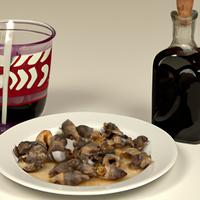
1 serving (100 grams) contains 172 calories, 29.0 grams of protein, 4.5 grams of fat, and 0.0 grams of carbohydrates.

Log this food in SnapCalorie

Nutrition Information
Calories |
409.5 | ||
|---|---|---|---|
% Daily Value* |
|||
| Total Fat | 10.7 g | 13% | |
| Saturated Fat | 2.9 g | 14% | |
| Polyunsaturated Fat | 0 g | ||
| Cholesterol | 152.4 mg | 50% | |
| Sodium | 133.3 mg | 5% | |
| Total Carbohydrates | 0 g | 0% | |
| Dietary Fiber | 0 g | 0% | |
| Sugars | 0 g | ||
| protein | 69.0 g | 138% | |
| Vitamin D | 0 mcg | 0% | |
| Calcium | 219.0 mg | 16% | |
| Iron | 34.5 mg | 191% | |
| Potassium | 747.6 mg | 15% | |
* Percent Daily Values are based on a 2,000 calorie diet. Your daily values may be higher or lower depending on your calorie needs.
Food Attributes
Source of Calories
About Pipis
Pipis are small, edible saltwater clams commonly found in Australian waters and often featured in coastal cuisines. Celebrated for their mild, slightly sweet flavor, pipis are a versatile ingredient in dishes like pasta, curries, and seafood stews. Rich in protein and low in fat, they provide a nutritious source of essential vitamins and minerals, including vitamin B12, iron, and omega-3 fatty acids, which are beneficial for heart health and brain function. Pipis are also a good source of iodine, supporting healthy thyroid function. However, being shellfish, they can pose risks for individuals with allergies and should always be consumed properly cooked to avoid foodborne illnesses. Sustainable harvesting practices are crucial for preserving pipis as a resource, making locally sourced options the best choice for environmentally conscious consumers. Enjoyed for centuries in coastal diets, pipis remain a cherished delicacy and a healthy addition to seafood-based meals.



